Categories
Archives
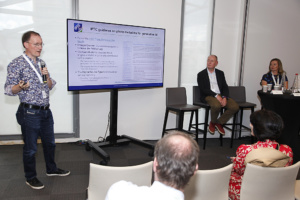
Next week, speakers from the National Geographic Society, Journalism Trust Initiative, Peking University and more will be presenting at the IPTC Spring Meeting in Juan les Pins, France.
This year’s event is being held in collaboration with CEPIC, the industry group for the image licensing industry, with whom IPTC has a long association. The CEPIC event is being held from Monday to Wednesday, and the IPTC event is from the Wednesday to Friday, so we can enjoy a crossover day where CEPIC attendees will be able to hear from IPTC speakers and vice versa.
Speakers and panels include:
- A panel discussion on AI opt-out best practices, discussing what publishers can practically do in today’s ecosystem to ensure that they have control over whether AI crawlers can index their content
- Several presentations on C2PA and Media Provenance, including a presentation of a proof-of-concept by the National Geographic Society working with Orange Logic and Trufo. We will also be holding a meeting of the IPTC Media Provenance Committee and workshops on metadata for C2PA in the news media industry
- Presentation from IPTC member Data Language on their recent work implementing IPTC Sport Schema in their Data Graphs platform
- Invited speakers from Peking University, working with IPTC member Xinhua News Agency, on pre-training AI models for media
- Presentations from each IPTC Working Group: NewsML-G2, News in JSON, Photo Metadata, Video Metadata, NewsCodes, Sports Content
Of course there will also be time for attendees to discuss shared issues in person with their peers from other companies around the globe.
Virtual attendance is still available. IPTC members should fill in the attendance form linked from the event page in the IPTC Members Only Zone.
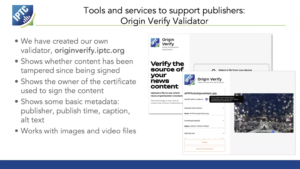
Brendan Quinn of IPTC presented alongside Leonard Rosenthol of C2PA at the World-Wide Web Consortium (W3C)’s Authentic Web workshop series this week.
This was the second in a series of online workshops run by the W3C in an effort to bring together the various work on trust, provenance, credibility and authenticity. The first part of the Authentic Web workshop was run in March 2025.
Leonard presented C2PA, its motivations and work done so far, including describing how C2PA technology is currently used by platforms such as LinkedIn and TikTok, and by most generative AI tools to signal AI-generated content.
Then Brendan went on to describe how the IPTC’s Media Provenance Committee has established the Verified News Publisher programme, an industry specific “trust list” of media organisations who are using C2PA certificates to sign their published content.
W3C events mostly run in the open, so the session agenda, pre-read material, minutes and even a video recording of the presentation part of the workshop are all available online, even to non-members. As per W3C policy, the discussion portion of the event was not recorded. This allows for more open discussion.
Present at the workshop were representatives of Google Chrome and Mozilla, the W3C’s Technical Architecture Group (TAG), hardware and software vendors, and others with an interest in the idea of implementing content provenance solutions in their tools.
Depending on the outcome of discussions within the group and at further workshops, this work may lead to a physical meeting later this year.
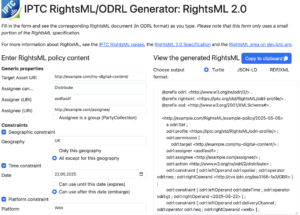
The IPTC has created a RightsML Generator tool that shows how easy it can be to generate simple RightsML documents expressing a range of permissions and obligations around the use of media content.
RightsML is the IPTC’s standard for expressing rights usage statements that can be used for all types of media content, from images and video clips through to AI data, data sets and 3D models. Since version 2.0, RightsML has been based on the World Wide Web Consortium (W3C)‘s Open Digital Rights Language (ODRL); in fact IPTC members worked closely with the W3C to create the current version of ODRL to align with RightsML.
A common complaint among users and potential users of RightsML and ODRL was that it is too complicated to be implemented easily. To answer these issues, we wanted to show that describing rights in RightsML can be relatively simple, especially for common news workflows and rights statements such as:
- “this content may be distributed in all countries except the UK” or “only in the UK” (a common use case for news and image licensing agencies that have operations in one country but allow other agencies to distribute their content in other countries)
- “this content may be published any time after XX date” (a simple “embargo”)
- “this content may be published any time until YY date” (a content expiry notice, which might apply to customers with certain types of licence)
- “this content may be published only on mobile platforms” or “only in print” (based on licensing agreements)
- “this content may be published only to those who have paid a licensing fee”
- or a combination of the above constraints.
To demonstrate these possibilities, we have created a simple form-based tool that generates the relevant RightsML/ODRL document. The user can choose whether to express the RightsML statements in various RDF formats: Turtle, RDF/XML and JSON-LD.
The RightsML generator tool can be accessed at https://iptc.org/std/RightsML/generator/.
Please contact IPTC or post on the public iptc-rightsml discussion group with any feedback or comments. We would love to hear from current and potential users of RightsML to learn how we can make the ecosystem easier for you.

The following is a guest post from Helge O. Svela, CEO of Media Cluster Norway. Media Cluster Norway joined the IPTC as Associate Members of IPTC in 2024 and Helge is the lead of the Provenance Best Practices and Implementation Working Group, where news publishers work together to talk about their progress in implementing C2PA and the IPTC Verified News Publisher programme within their organisations.
In this article, Helge introduces Project Reynir, an initiative to bring secure media signing technology to the Norwegian media industry.
The journalistic institution must rethink how it develops and applies technology if society is to stand a chance against the deluge of fake images and video from generative AI. Never before in human history has it been easier to produce realistic, but fake, images and video, and spread them around the world. The rapid technological development of generative artificial intelligence has turbocharged the engines of disinformation, and caught both society and journalism off-guard. Never have we been more vulnerable.
Disinformation is destabilising our democracies, and spreading erroneous information. This potentially has severe consequences for both democratic processes and for the public in the face of natural disasters and other crises. The first round of the Romanian elections in 2024 was annulled due to what was dubbed an “algorithmic invasion” of social media disinformation. In the aftermath of the earthquake in Myanmar in March, AI-generated videos of the devastating destruction shared by so called “engagement farmers”, likely with financial motives, got millions of views on social media.
Generative AI has given humanity the ability to create realistic videos and images simply by typing a few words into a website. However, these tools also quickly became a part of the arsenal for enemies of democracy. As a result, disinformation is becoming more prevalent, appearing more professional and costing almost nothing to produce. Generative AI is an industrial revolution also for the troll factories in Russia and others who seek to manipulate our perception of the world and sow doubt about what is true.
This is not a media problem. It is a democratic problem, and a dangerous one at that. Disinformation created by troll factories and generative artificial intelligence and spread by bots pose an immediate threat to our democracies. We might end up doubting absolutely everything. When anyone can claim anything is generated and fake, the liars come out on top. This could destroy the foundation of our democracies: trust in each other and in our institutions. One thing is current news, another is history. Imagine a dictator using fake historical footage of a hunger catastrophe in order to justify an ethnic cleansing of a minority. An internet flooded with claims and visual “proof” of what happened in the past, all of which looks authentic. As a result of generative AI this is no longer just a dystopian science fiction scenario. It is a real possibility. Never before have we needed editorial media more. However, the signal strength of editorial media risks being drowned out by an ever growing cacophony of junk content and disinformation.
Project Reynir is our response to the threat Generative AI poses. Because Generative AI makes it so easy to fake both content and sender, editorial media are under threat on two fronts. In Project Reynir, we aim to solve this problem using technical solutions.
The goal is to create something that makes it easier for ordinary people to distinguish between what is fake and what is real. By using cryptographically secured images and video, based on the open C2PA specification, it is possible for both newsrooms and regular media users to be confident that the images we are seeing have not been tampered with on their journey from the photographer’s lens to the mobile screen. Moreover, using the same technology, authenticity markers can be added to the images and videos from news publishers when they post stories on social media and other third party platforms. Thus guaranteeing that content that appears to be the BBC and AFP actually is from these news organisations and not someone impersonating them. If we succeed, we will be a significant step closer to solving the problem of artificially created noise for our present moment. Project Reynir unites newsrooms, media technology companies and academic researchers in the fight against disinformation. Our goal is an 80 percent adoption in the Norwegian news ecosystem, and to serve as a beacon of best practices for the rest of the world of news.
We believe that time is critical, and that all good forces now must unite. The technological development has moved rapidly in the last few years, and the adoption of technology has sometimes been irresponsible. If our democracies are to stand firm in the face of the disinformation tsunami we are facing, quality journalism must be empowered. Only then can we enable citizens to make informed choices free of manipulation and interference, in an environment where facts can be easily distinguished from lies. We call for the democratic governments of the world to invest in innovation in the news media space. The time for responsible tech innovation, made with resilient democracies in mind, is now.
This article was originally published in the report Seeking Truth, Ensuring Quality: Journalistic Weapons in the Age of Disinformation, published by the University of Bergen in collaboration with Media Cluster Norway, as a part of the Journalistic Weapons conference organised in Brussels on April 28 2025. The full report, including articles from Faktisk, the European Federation of Journalists, London School of Economics, the Center for Investigative Journalism Norway and others, is available at https://www.uib.no/sites/w3.uib.no/files/attachments/publication_seeking_truth_ensuring_quality.pdf.
Broadcast and entertainment companies including Disney, Sony Pictures, Gracenote, Sinclair, Amazon MGM heard from the IPTC’s Pam Fisher this week at the 2025 EIDR Annual Participant Meeting.
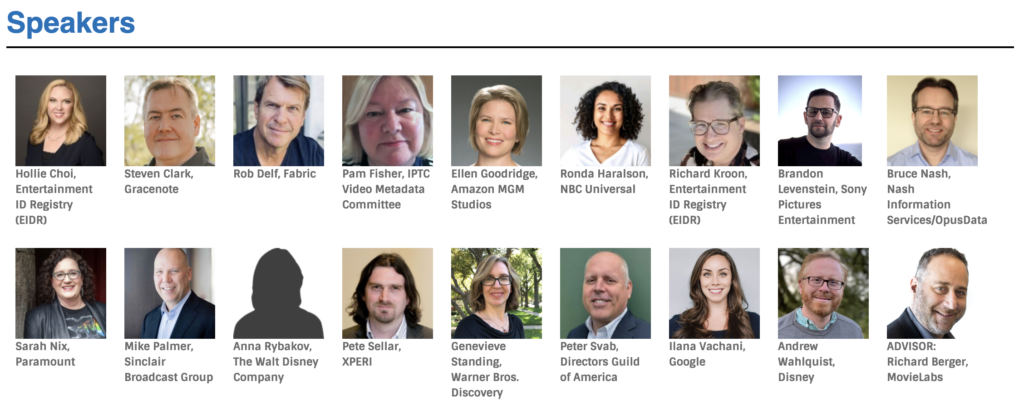
Pam is Lead of the IPTC Video Metadata Working Group, maintainers of the IPTC Video Metadata Hub standard. Pam spoke about IPTC’s work in video metadata and also our efforts in publisher provenance and credibility, particularly the work of the IPTC Media Provenance Committee.
The IPTC Verified News Publishers List is of particular interest to EIDR members who are keen to sign their content and ensure provenance and authenticity, similarly to news publishers. Pam talked gave a status update on the Verified News Publishers List, telling attendees that we now have between 10 and 20 publishers either with certificates or in the process of obtaining certificates.
Pam’s message to EIDR members, and the entertainment media industry in general, was to be patient: media provenance using C2PA is worth supporting, and broad adoption will become feasible over the next 6 to 18 months. The IPTC is figuring out a way forward using the news media industry as a test case. The goal is that once we have a system that works well in the news industry, we will be able to scale up to other types of media providers and publishers.
For more information on IPTC’s Media Provenance work or the Verified News Publisher List, please contact IPTC.
At the 2024 IPTC Photo Metadata Conference, James Lockman of Adobe’s Digital Media Services division demonstrated the Custom Metadata Panel, a tool that allows users to create their own user interface for editing sets of metadata fields. Since that time, the IPTC has worked with James and his team to make the tool even more useful, supporting the full set of IPTC properties and even enabling IPTC Photo Metadata as the default view in the tool.

The plugin can be installed from the Adobe Exchange plugin directory, and more information is available on the plugin’s GitHub repository, in particular the repository’s wiki pages.
For guidance on how to use the Custom Metadata Panel for editing IPTC metadata specifically, the IPTC Photo Metadata Working Group has created both a guide to installing the Custom Metadata Panel and a user guide for editing IPTC Photo Metadata using the Adobe Custom Metadata Panel. Together, the guidance pages explain how to install the tool, how to set it up for editing IPTC metadata, and some specific advice for editing particular types of metadata using the tool.
Support for both photo and video metadata
The Custom Metadata Panel also supports IPTC’s equivalent standard for video content, IPTC Video Metadata Hub. We will add guidance in the future for how it can be used to edit Video Metadata Hub metadata from within Adobe Premiere Pro.
The IPTC thanks James and his team for their work on the panel and for enhancing it so well over the past 12 months to turn it into a real power tool for media managers who want the full power of IPTC Photo Metadata at their fingertips.
Hands-on metadata workshop in Juan les Pins, France in May 2025
IPTC Managing Director Brendan Quinn will run a workshop on Wednesday 14th May showing users how to activate the plugin and how to use it to edit metadata for various purposes. This workshop will take place as part of the IPTC Day at CEPIC 2025, and so will be accessible to attendees of CEPIC 2025 and of the IPTC 2025 Spring Meeting.
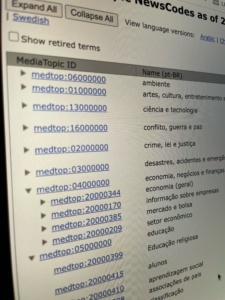
The IPTC NewsCodes Working Group is pleased to present the Q1 2025 release of IPTC NewsCodes.
As usual, most of the updates are in our flagship subject vocabulary, Media Topics.
Media Topic updates
This release adds 8 new concepts, retires 17 concepts, modifies 43 label names and 64 definitions, adds 10 notes (mostly to retired concepts), makes 28 hierarchy moves and modifies 7 wikidata mappings.
The new and modified terms have already been translated into Swedish (lang=se) and Norwegian (lang=no-NB and lang=no-NN)
New concepts (8 terms)
zoning policy, political party, political movement and association, communism, democratic socialism, theocracy, absolute monarchy, ski mountaineering
Note that ski mountaineering (medtop:20001390) has been added to the Media Topics vocabulary because it was added as a new sport for the 2026 Olympics.
Retired concepts (17 terms)
- civil and public service – use government employee (medtop:20000595) instead.
- military equipment – use military weaponry and equipment (medtop:20000602) instead.
- security measures (defence) – use national security (medtop:20000598) instead.
- national security (old) – Use national security (medtop:20000598) instead.
- public finance – Use government budget (medtop:20000607) or government debt (medtop:20000368) instead.
- government department – Use more specific terms or government (medtop:20000593) instead.
- safety of citizens – Use other terms such as public health (medtop:20001358) or emergency response (medtop:20000168) instead.
- interior policy – Use more specific terms instead.
- personal data collection policy – Use data protection policy (medtop:20000627) instead.
- planning inquiries – Use zoning policy (medtop:20001383), environmental policy (medtop:20000423) or other more specific terms instead.
- political crisis – Use more specific terms instead.
- political process – Use government (medtop:20000593) or other more specific terms instead.
- political parties and movements – Use political party (medtop:20001384) or political movement and association (medtop:20001385) instead.
- political development – Use politics (medtop:11000000) instead.
- civilian service – Use medtop:20001277 volunteering instead.
- integration policy – Use immigration policy (medtop:20000634) instead.
- regulatory authority – Use regulation of industry (medtop:20000636) instead.
Modified labels (43 terms)
politics and government, demonstration, government employee, public officials, constitution (law).
national security.military weaponry and equipment, head of state,local authority, minister or secretary (government), regional authority, taxation policy, data protection policy, immigration policy, summit meeting, treaty, foreign aid, international organisation, refugees and internally displaced people, non-governmental organisation (NGO), political prisoners and dissenters, cultural policy, sports policies, political party convention, political committee, head of government, border dispute, financial service, corporate bond, war victims, missing in action, breaking (breakdance), by-election, recall election, coalition building, zoning policy, political party, political movement and association, communism, democratic socialism, theocracy, absolute monarchy, ski mountaineering.
Modified definitions (64 terms)
politics and government, demonstration, computer networking, economic policy, environmental policy, healthcare policy, government, government employee, public officials, constitution (law), national security, armed forces, military weaponry and equipment, executive (government), government budget, head of state, local authority, minister or secretary (government), regional authority, taxation policy, government policy, nationalisation, privatisation, state-owned enterprise, data protection policy, policy towards indigenous people, pension and welfare policy, personal weapon control policy, immigration policy, nuclear policy, regulation of industry, food and drink regulations, international relations, diplomacy, summit meeting, treaty, economic sanction, foreign aid, international organisation, refugees and internally displaced people, non-governmental organisation (NGO), political prisoners and dissenters, lobbying, political system, democracy, dictatorship, cultural policy, sports policies, regional development policy, political party convention, head of government, infrastructure policy, economic development incentive, political leadership, border dispute, education policy, zoning policy, political party, political movement and association, communism, democratic socialism, theocracy, absolute monarchy, ski mountaineering.
Modified notes (10 terms)
safety of citizens, interior policy, personal data collection policy, planning inquiries, political crisis, political process, political parties and movements, political development, civilian service, integration policy.
Modified broader terms (hierarchy moves) (28 terms)
campaign finance, government employee, public officials, military weaponry and equipment, espionage and intelligence, data protection policy, housing and urban planning policy, policy towards indigenous people, pension and welfare policy, personal data collection policy, personal weapon control policy, planning inquiries, lobbying, political parties and movements, political development, political system, integration policy, regional development policy, infrastructure policy, political leadership, zoning policy, political party, political movement and association, communism, democratic socialism, theocracy, absolute monarchy, ski mountaineering.
Modified wikidata mappings: 7
political party, political movement and association, communism, democratic socialism, theocracy, absolute monarchy, ski mountaineering.
See the official Media Topic vocabulary on the IPTC Controlled Vocabulary server, and an easier-to-navigate tree view. An Excel version of IPTC Media Topics is also available.
Non-Media Topic changes
- New term: Software
- New terms: anonymised, recommended anonymisation

“It has never been more important to safeguard authentic news media,” say the organisers.
“We must strengthen our voice and hold our ground against the big tech players. It is critical that the industry works together,” said Fabrice Fries, Chief Executive Officer at AFP, in his opening remarks for the workshop in Paris.
“At AFP we are committed to ensure that both news organisations and the general public can inspect the provenance of our images. This transparency builds trust,” said Eric Baradat, the global news deputy director for photo and archives at AFP.
AFP, BBC and Media Cluster Norway jointly organised the workshop, which was hosted by AFP and supported by the International Press Telecommunications Council (IPTC). The workshop focused on image metadata and how the C2PA standard, also known as Content Credentials, can safeguard it.
“The challenges the news industry are facing are so great that we can only succeed if we work together. Making sure the public can discern between authentic media and content made by generative AI is vital not only for news organisations, but for democratic societies,” said Helge O. Svela, CEO of Media Cluster Norway.
More than 40 people from over 20 news organisations participated in the full day workshop. Among the presentations was a study commissioned by Media Cluster Norway’s Project Reynir on how media consumers respond to being shown more detailed information about an image. The study was conducted by MediaFutures at the University of Bergen, and built on a user study conducted by the BBC.
“Trust is earned. At the BBC we have seen that users really engage when we show them how their news was made. Extra media provenance details such as when and where an image was taken, or the steps used to verify it, make a real difference to how users trust their news. The C2PA standard can allow us to share this information with the users in a secure and trustworthy way,” said Judy Parnall, Principal Technologist, BBC Research and Development.
Among the participants in the workshop were CBC-Radio Canada, Deutsche Welle, France TV, ITV, NHK and Al Jazeera. Topics discussed included carrying provenance metadata from glass to glass versus adding it at the point of publishing, as well as the importance of redaction to the media industry and content provenance for media archives.
“It is vital that the needs of the news media ecosystem are heard as this technology and standards are further developed and refined,” said Brendan Quinn, Managing Director at IPTC.
The IPTC Media Provenance Committee works on several initiatives for implementing and furthering the development of the C2PA technology for the media industry. Many of the speakers and participants of the Paris workshop are actively involved in this work.
For more information on IPTC and the Media Provenance Committee, contact the IPTC via this site.
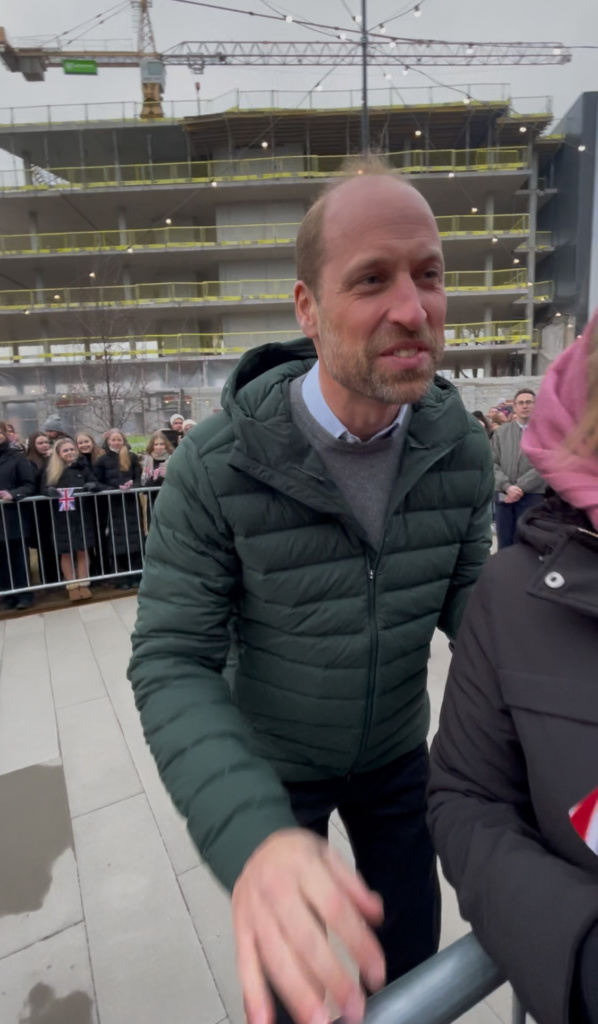
The IPTC has developed a WordPress plugin that automatically signs all images and video content published on a WordPress site. It has been put to use to automatically sign all images attached to IPTC news posts, such as this one, at the moment of publishing.
Based on our library of signing tools which are available to IPTC members, the “C2PA Signer” plugin takes action when a WordPress user publishes a new post. The plugin automatically retrieves all images (in all available sizes) and signs each image using the private key associated with the publisher.
The tool also extracts relevant metadata from WordPress. Each image’s caption, alt text, image upload date and publish date are embedded into the signed C2PA Manifest using an early version of the Origin IPTC Verified News Publisher metadata assertion. The specification of this assertion is currently in flux and the example assertion should not be relied on for production use, although the assertion is supported by the IPTC’s C2PA validator tool, Origin Verify.
Click here to view the image’s signed metadata using the Origin Verify tool.
This is in line with the goals of our IPTC Origin Verified News Publisher project, whereby publishers sign their own content using their own certificate. This enables publishers to take ownership of their content and to assert important facts about their content at the time of publishing.
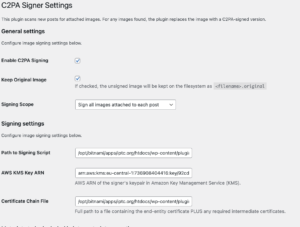 |
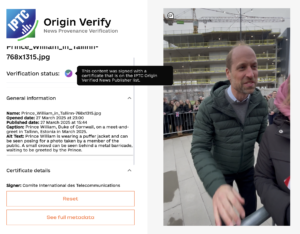 |
In related news, the IPTC now has its own C2PA certificate, issued by GlobalSign under the IPTC’s official name, “Comite International des Telecommunications de Presse.” This means that the IPTC can be the first entity to use the new plugin.
“We are very happy to launch the new WordPress plugin, which we of course are using on our own website,” says Brendan Quinn, Managing Director, IPTC. “We believe that this makes us the first organisation to routinely sign all images that we publish using our C2PA credentials.”
The certificates, manifests and the signed content are fully compatible with the latest version of C2PA, version 2.1. Images that we publish (including the image on this post) can be verified using the Origin Verify validator or the C2PA Content Credentials Verify validator.
For more information, contact IPTC using the Contact Us form.
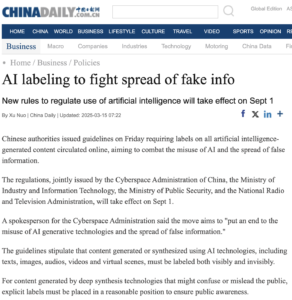
The news outlet China Daily reported on Friday that China will require all AI-generated content to be labelled from September 1st, 2025.
China Daily reports:
Chinese authorities issued guidelines on Friday requiring labels on all artificial intelligence-generated content circulated online, aiming to combat the misuse of AI and the spread of false information.
The regulations, jointly issued by the Cyberspace Administration of China, the Ministry of Industry and Information Technology, the Ministry of Public Security, and the National Radio and Television Administration, will take effect on Sept 1.
A spokesperson for the Cyberspace Administration said the move aims to “put an end to the misuse of AI generative technologies and the spread of false information.”
According to China Daily, “[t]he guidelines stipulate that content generated or synthesized using AI technologies, including texts, images, audios, videos and virtual scenes, must be labeled both visibly and invisibly” (emphasis added by IPTC). This potentially means that IPTC or another form of embedded metadata must be used, in addition to a visible watermark.
“Content identification numbers”
The article goes on to state that “[t]he guideline requires that implicit labels be added to the metadata of generated content files. These labels should include details about the content’s attributes, the service provider’s name or code, and content identification numbers.”
It is not clear from this article which particular identifiers should be used. There is currently no globally-recognised mechanism to identify individual pieces of content by identification numbers, although IPTC Photo Metadata does allow for image identifiers to be included via the Digital Image GUID property and the Video Metadata Hub Video Identifier field, which is based on Dublin Core’s generic dc:identifier property.
IPTC Photo Metadata’s Digital Source Type property is the global standard for identifying AI-generated images and video files, being used by Meta, Apple, Pinterest, Google and others, and also being adopted by the C2PA specification for digitally-signed metadata embedded in media files.
According to the article, “Service providers that disseminate content online must verify that the metadata of the content files contain implicit AIGC labels, and that users have declared the content as AI-generated or synthesized. Prominent labels should also be added around the content to inform users.”
Spain’s equivalent legislation on labelling AI-generated content
This follows on from Spain’s legislation requiring labelling of AI-generated content, announced last week.
The Spanish proposal has been approved by the upper house of parliament but must still be approved by the lower house. The legislation will be enforced by the newly-created Spanish AI supervisory agency AESIA.
If companies do not comply with the proposed Spanish legislation, they could incur fines of up to 35 million euros ($38.2 million) or 7% of their global annual turnover.